
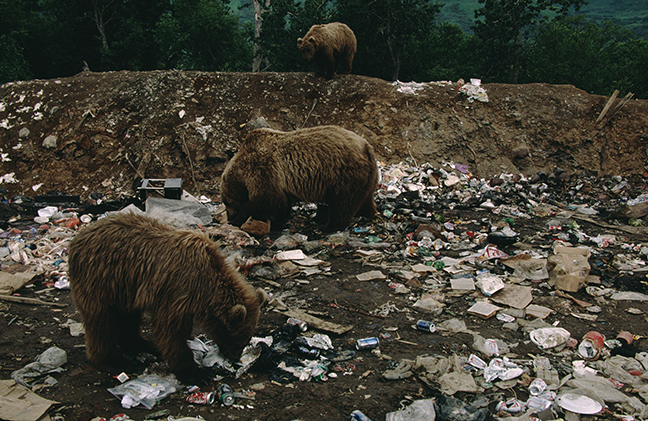
Larsen Bay is a small village of less than 90 people on a narrow fjord 60 miles southwest of the City of Kodiak with 5.4 square miles of land. Waterfront lodges feature guided fishing and hunting trips throughout the summer and fall. The Alutiiq village is the site of the largest repatriation of Native remains ever conducted by the Smithsonian when they reinterred the remains of 756 Alutiiq, who had been taken 50 years earlier, in a mass grave in 1991.
About a mile outside of the settlement is an open dumpsite that attracts brown bears that scour the trash for an easy meal and residents in their pick-up trucks who come to watch the show most evenings. Unfortunately, many of the bears learn to relate food to humans and eventually wander into town and get killed. (1/3)
©Rich Beckman


Larsen Bay is a small village of less than 90 people on a narrow fjord 60 miles southwest of the City of Kodiak with 5.4 square miles of land. Waterfront lodges feature guided fishing and hunting trips throughout the summer and fall. The Alutiiq village is the site of the largest repatriation of Native remains ever conducted by the Smithsonian when they reinterred the remains of 756 Alutiiq, who had been taken 50 years earlier, in a mass grave in 1991.
About a mile outside of the settlement is an open dumpsite that attracts brown bears that scour the trash for an easy meal and residents in their pick-up trucks who come to watch the show most evenings. Unfortunately, many of the bears learn to relate food to humans and eventually wander into town and get killed. (2/3)
©Rich Beckman

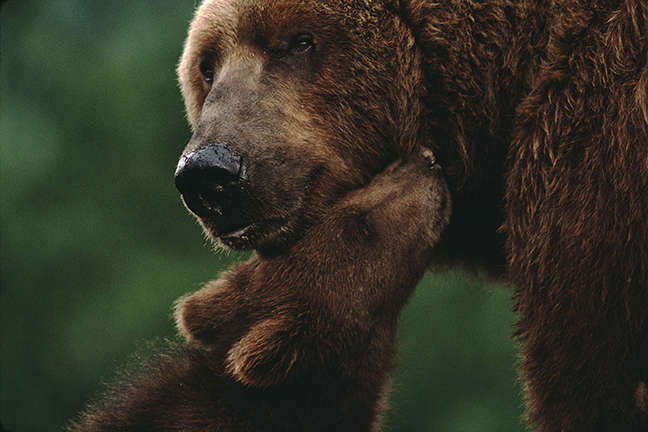
Larsen Bay is a small village of less than 90 people on a narrow fjord 60 miles southwest of the City of Kodiak with 5.4 square miles of land. Waterfront lodges feature guided fishing and hunting trips throughout the summer and fall. The Alutiiq village is the site of the largest repatriation of Native remains ever conducted by the Smithsonian when they reinterred the remains of 756 Alutiiq, who had been taken 50 years earlier, in a mass grave in 1991.
About a mile outside of the settlement is an open dumpsite that attracts brown bears that scour the trash for an easy meal and residents in their pick-up trucks who come to watch the show most evenings. Unfortunately, many of the bears learn to relate food to humans and eventually wander into town and get killed. (3/3)
©Rich Beckman

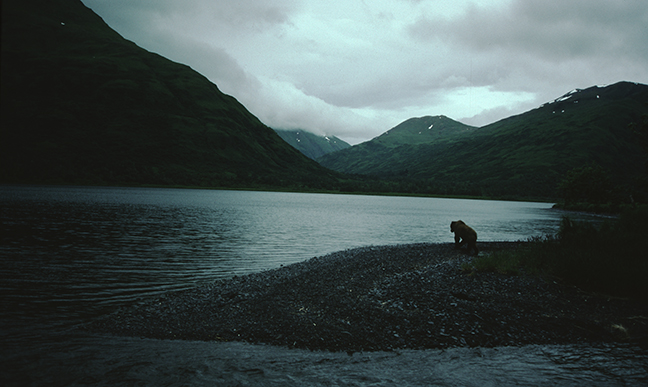
The O’Malley River connects Karluck and O’Malley Lakes on the southwest side of Kodiak Island and is the site of one of the largest concentrations of Brown Bears each summer and early fall when sockeye salmon are spawning. Before 1992, the O'Malley River area was open to unregulated public use. Then, the Kodiak National Wildlife Refuge decided that unregulated use was harming feeding bears and closed the area except for a highly structured bear-viewing program. Two years later, a private guide service operated the program but a legal challenge to the way Mike Munsey, the contractor, was selected shut down the program and since 1995, the O’Malley River area has been closed to public use from June 25-September 30.
Bear viewing began again in June 2011, managed by the ANCSA Regional Native Corporation, Koniag, Inc., which is the owner and operator of the Kodiak Brown Bear Center. Koniag is one of the Native Corporations created by Congress through the passage of the Alaska Native Claims Settlement Act (ANCSA) in 1971. The Center charges more than $1,000/day per person based on double occupancy with a four-day minimum stay.
The program is still controversial as the bear-viewing season ends on Sept. 30 and the bear hunting season begins on October 25, so bears that have been habituated to humans during the summer can be shot by them less than a month later.
The same program also includes bear viewing along Thumb Creek and the 22-mile long Karluk River from a luxury base on Camp Island. The Camp Island I knew and loved in the 1990s is a thing of the past. In those days Pete Devaris, owner of Wilderness Air and later Alaska Coastal Airlines, operated it. Onsite was the late Scott Shelton, who served as guide, cook, boat captain and storyteller. The cabins were simple and efficient and the patrons were friendly and respectful (and they still may be). They reflected Scott’s personality and I was happy to be able to honor him at his memorial service in Ketchikan. I returned only once to Camp Island after his death. My memories were too fresh and painful to enjoy the experience after so many years of sharing the place with him.
I see Pete Devaris and his lovely family regularly in Alaska and he remains a source of inspiration for my work in Alaska. (1/12)
©Rich Beckman


The O’Malley River connects Karluck and O’Malley Lakes on the southwest side of Kodiak Island and is the site of one of the largest concentrations of Brown Bears each summer and early fall when sockeye salmon are spawning. Before 1992, the O'Malley River area was open to unregulated public use. Then, the Kodiak National Wildlife Refuge decided that unregulated use was harming feeding bears and closed the area except for a highly structured bear-viewing program. Two years later, a private guide service operated the program but a legal challenge to the way Mike Munsey, the contractor, was selected shut down the program and since 1995, the O’Malley River area has been closed to public use from June 25-September 30.
Bear viewing began again in June 2011, managed by the ANCSA Regional Native Corporation, Koniag, Inc., which is the owner and operator of the Kodiak Brown Bear Center. Koniag is one of the Native Corporations created by Congress through the passage of the Alaska Native Claims Settlement Act (ANCSA) in 1971. The Center charges more than $1,000/day per person based on double occupancy with a four-day minimum stay.
The program is still controversial as the bear-viewing season ends on Sept. 30 and the bear hunting season begins on October 25, so bears that have been habituated to humans during the summer can be shot by them less than a month later.
The same program also includes bear viewing along Thumb Creek and the 22-mile long Karluk River from a luxury base on Camp Island. The Camp Island I knew and loved in the 1990s is a thing of the past. In those days Pete Devaris, owner of Wilderness Air and later Alaska Coastal Airlines, operated it. Onsite was the late Scott Shelton, who served as guide, cook, boat captain and storyteller. The cabins were simple and efficient and the patrons were friendly and respectful (and they still may be). They reflected Scott’s personality and I was happy to be able to honor him at his memorial service in Ketchikan. I returned only once to Camp Island after his death. My memories were too fresh and painful to enjoy the experience after so many years of sharing the place with him.
I see Pete Devaris and his lovely family regularly in Alaska and he remains a source of inspiration for my work in Alaska. (2/12)
©Rich Beckman


The O’Malley River connects Karluck and O’Malley Lakes on the southwest side of Kodiak Island and is the site of one of the largest concentrations of Brown Bears each summer and early fall when sockeye salmon are spawning. Before 1992, the O'Malley River area was open to unregulated public use. Then, the Kodiak National Wildlife Refuge decided that unregulated use was harming feeding bears and closed the area except for a highly structured bear-viewing program. Two years later, a private guide service operated the program but a legal challenge to the way Mike Munsey, the contractor, was selected shut down the program and since 1995, the O’Malley River area has been closed to public use from June 25-September 30.
Bear viewing began again in June 2011, managed by the ANCSA Regional Native Corporation, Koniag, Inc., which is the owner and operator of the Kodiak Brown Bear Center. Koniag is one of the Native Corporations created by Congress through the passage of the Alaska Native Claims Settlement Act (ANCSA) in 1971. The Center charges more than $1,000/day per person based on double occupancy with a four-day minimum stay.
The program is still controversial as the bear-viewing season ends on Sept. 30 and the bear hunting season begins on October 25, so bears that have been habituated to humans during the summer can be shot by them less than a month later.
The same program also includes bear viewing along Thumb Creek and the 22-mile long Karluk River from a luxury base on Camp Island. The Camp Island I knew and loved in the 1990s is a thing of the past. In those days Pete Devaris, owner of Wilderness Air and later Alaska Coastal Airlines, operated it. Onsite was the late Scott Shelton, who served as guide, cook, boat captain and storyteller. The cabins were simple and efficient and the patrons were friendly and respectful (and they still may be). They reflected Scott’s personality and I was happy to be able to honor him at his memorial service in Ketchikan. I returned only once to Camp Island after his death. My memories were too fresh and painful to enjoy the experience after so many years of sharing the place with him.
I see Pete Devaris and his lovely family regularly in Alaska and he remains a source of inspiration for my work in Alaska. (3/12)
©Rich Beckman

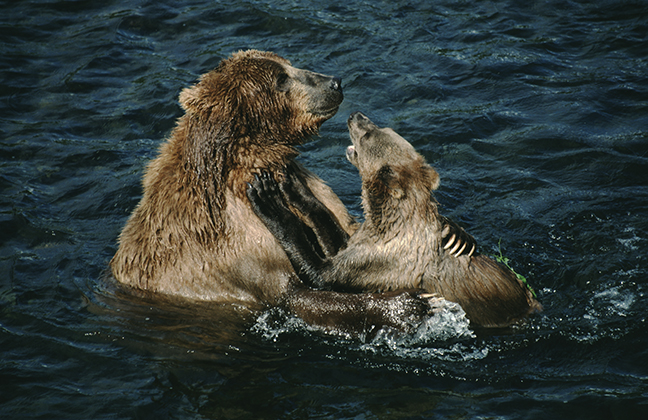
The O’Malley River connects Karluck and O’Malley Lakes on the southwest side of Kodiak Island and is the site of one of the largest concentrations of Brown Bears each summer and early fall when sockeye salmon are spawning. Before 1992, the O'Malley River area was open to unregulated public use. Then, the Kodiak National Wildlife Refuge decided that unregulated use was harming feeding bears and closed the area except for a highly structured bear-viewing program. Two years later, a private guide service operated the program but a legal challenge to the way Mike Munsey, the contractor, was selected shut down the program and since 1995, the O’Malley River area has been closed to public use from June 25-September 30.
Bear viewing began again in June 2011, managed by the ANCSA Regional Native Corporation, Koniag, Inc., which is the owner and operator of the Kodiak Brown Bear Center. Koniag is one of the Native Corporations created by Congress through the passage of the Alaska Native Claims Settlement Act (ANCSA) in 1971. The Center charges more than $1,000/day per person based on double occupancy with a four-day minimum stay.
The program is still controversial as the bear-viewing season ends on Sept. 30 and the bear hunting season begins on October 25, so bears that have been habituated to humans during the summer can be shot by them less than a month later.
The same program also includes bear viewing along Thumb Creek and the 22-mile long Karluk River from a luxury base on Camp Island. The Camp Island I knew and loved in the 1990s is a thing of the past. In those days Pete Devaris, owner of Wilderness Air and later Alaska Coastal Airlines, operated it. Onsite was the late Scott Shelton, who served as guide, cook, boat captain and storyteller. The cabins were simple and efficient and the patrons were friendly and respectful (and they still may be). They reflected Scott’s personality and I was happy to be able to honor him at his memorial service in Ketchikan. I returned only once to Camp Island after his death. My memories were too fresh and painful to enjoy the experience after so many years of sharing the place with him.
I see Pete Devaris and his lovely family regularly in Alaska and he remains a source of inspiration for my work in Alaska. (4/12)
©Rich Beckman

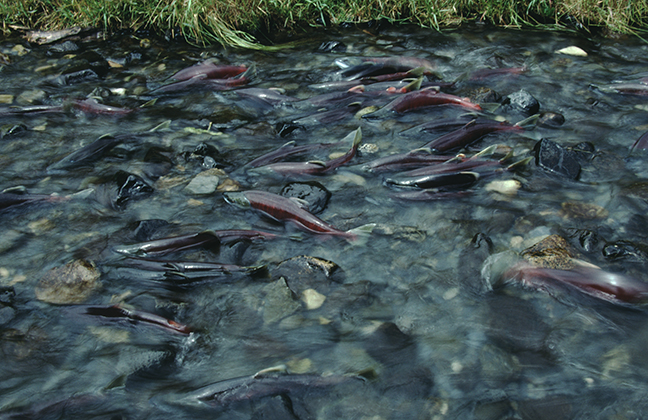
The O’Malley River connects Karluck and O’Malley Lakes on the southwest side of Kodiak Island and is the site of one of the largest concentrations of Brown Bears each summer and early fall when sockeye salmon are spawning. Before 1992, the O'Malley River area was open to unregulated public use. Then, the Kodiak National Wildlife Refuge decided that unregulated use was harming feeding bears and closed the area except for a highly structured bear-viewing program. Two years later, a private guide service operated the program but a legal challenge to the way Mike Munsey, the contractor, was selected shut down the program and since 1995, the O’Malley River area has been closed to public use from June 25-September 30.
Bear viewing began again in June 2011, managed by the ANCSA Regional Native Corporation, Koniag, Inc., which is the owner and operator of the Kodiak Brown Bear Center. Koniag is one of the Native Corporations created by Congress through the passage of the Alaska Native Claims Settlement Act (ANCSA) in 1971. The Center charges more than $1,000/day per person based on double occupancy with a four-day minimum stay.
The program is still controversial as the bear-viewing season ends on Sept. 30 and the bear hunting season begins on October 25, so bears that have been habituated to humans during the summer can be shot by them less than a month later.
The same program also includes bear viewing along Thumb Creek and the 22-mile long Karluk River from a luxury base on Camp Island. The Camp Island I knew and loved in the 1990s is a thing of the past. In those days Pete Devaris, owner of Wilderness Air and later Alaska Coastal Airlines, operated it. Onsite was the late Scott Shelton, who served as guide, cook, boat captain and storyteller. The cabins were simple and efficient and the patrons were friendly and respectful (and they still may be). They reflected Scott’s personality and I was happy to be able to honor him at his memorial service in Ketchikan. I returned only once to Camp Island after his death. My memories were too fresh and painful to enjoy the experience after so many years of sharing the place with him.
I see Pete Devaris and his lovely family regularly in Alaska and he remains a source of inspiration for my work in Alaska. (5/12)
©Rich Beckman

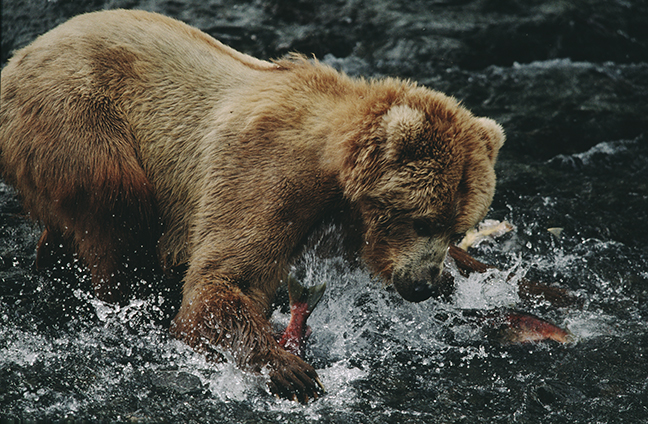
The O’Malley River connects Karluck and O’Malley Lakes on the southwest side of Kodiak Island and is the site of one of the largest concentrations of Brown Bears each summer and early fall when sockeye salmon are spawning. Before 1992, the O'Malley River area was open to unregulated public use. Then, the Kodiak National Wildlife Refuge decided that unregulated use was harming feeding bears and closed the area except for a highly structured bear-viewing program. Two years later, a private guide service operated the program but a legal challenge to the way Mike Munsey, the contractor, was selected shut down the program and since 1995, the O’Malley River area has been closed to public use from June 25-September 30.
Bear viewing began again in June 2011, managed by the ANCSA Regional Native Corporation, Koniag, Inc., which is the owner and operator of the Kodiak Brown Bear Center. Koniag is one of the Native Corporations created by Congress through the passage of the Alaska Native Claims Settlement Act (ANCSA) in 1971. The Center charges more than $1,000/day per person based on double occupancy with a four-day minimum stay.
The program is still controversial as the bear-viewing season ends on Sept. 30 and the bear hunting season begins on October 25, so bears that have been habituated to humans during the summer can be shot by them less than a month later.
The same program also includes bear viewing along Thumb Creek and the 22-mile long Karluk River from a luxury base on Camp Island. The Camp Island I knew and loved in the 1990s is a thing of the past. In those days Pete Devaris, owner of Wilderness Air and later Alaska Coastal Airlines, operated it. Onsite was the late Scott Shelton, who served as guide, cook, boat captain and storyteller. The cabins were simple and efficient and the patrons were friendly and respectful (and they still may be). They reflected Scott’s personality and I was happy to be able to honor him at his memorial service in Ketchikan. I returned only once to Camp Island after his death. My memories were too fresh and painful to enjoy the experience after so many years of sharing the place with him.
I see Pete Devaris and his lovely family regularly in Alaska and he remains a source of inspiration for my work in Alaska. (6/12)
©Rich Beckman

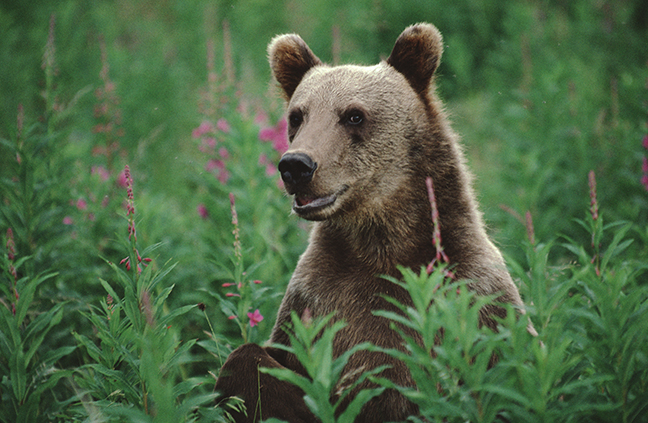
The O’Malley River connects Karluck and O’Malley Lakes on the southwest side of Kodiak Island and is the site of one of the largest concentrations of Brown Bears each summer and early fall when sockeye salmon are spawning. Before 1992, the O'Malley River area was open to unregulated public use. Then, the Kodiak National Wildlife Refuge decided that unregulated use was harming feeding bears and closed the area except for a highly structured bear-viewing program. Two years later, a private guide service operated the program but a legal challenge to the way Mike Munsey, the contractor, was selected shut down the program and since 1995, the O’Malley River area has been closed to public use from June 25-September 30.
Bear viewing began again in June 2011, managed by the ANCSA Regional Native Corporation, Koniag, Inc., which is the owner and operator of the Kodiak Brown Bear Center. Koniag is one of the Native Corporations created by Congress through the passage of the Alaska Native Claims Settlement Act (ANCSA) in 1971. The Center charges more than $1,000/day per person based on double occupancy with a four-day minimum stay.
The program is still controversial as the bear-viewing season ends on Sept. 30 and the bear hunting season begins on October 25, so bears that have been habituated to humans during the summer can be shot by them less than a month later.
The same program also includes bear viewing along Thumb Creek and the 22-mile long Karluk River from a luxury base on Camp Island. The Camp Island I knew and loved in the 1990s is a thing of the past. In those days Pete Devaris, owner of Wilderness Air and later Alaska Coastal Airlines, operated it. Onsite was the late Scott Shelton, who served as guide, cook, boat captain and storyteller. The cabins were simple and efficient and the patrons were friendly and respectful (and they still may be). They reflected Scott’s personality and I was happy to be able to honor him at his memorial service in Ketchikan. I returned only once to Camp Island after his death. My memories were too fresh and painful to enjoy the experience after so many years of sharing the place with him.
I see Pete Devaris and his lovely family regularly in Alaska and he remains a source of inspiration for my work in Alaska. (7/12)
©Rich Beckman

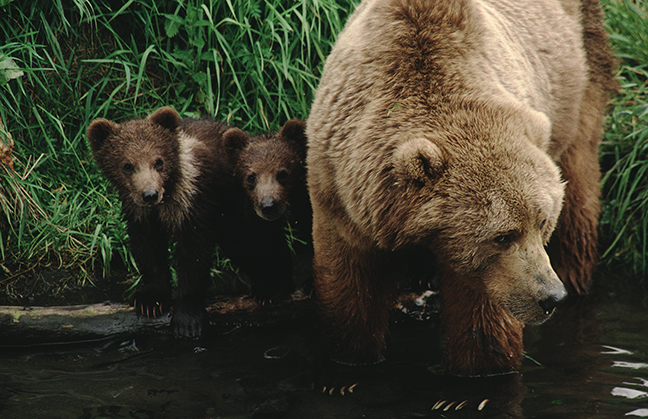
The O’Malley River connects Karluck and O’Malley Lakes on the southwest side of Kodiak Island and is the site of one of the largest concentrations of Brown Bears each summer and early fall when sockeye salmon are spawning. Before 1992, the O'Malley River area was open to unregulated public use. Then, the Kodiak National Wildlife Refuge decided that unregulated use was harming feeding bears and closed the area except for a highly structured bear-viewing program. Two years later, a private guide service operated the program but a legal challenge to the way Mike Munsey, the contractor, was selected shut down the program and since 1995, the O’Malley River area has been closed to public use from June 25-September 30.
Bear viewing began again in June 2011, managed by the ANCSA Regional Native Corporation, Koniag, Inc., which is the owner and operator of the Kodiak Brown Bear Center. Koniag is one of the Native Corporations created by Congress through the passage of the Alaska Native Claims Settlement Act (ANCSA) in 1971. The Center charges more than $1,000/day per person based on double occupancy with a four-day minimum stay.
The program is still controversial as the bear-viewing season ends on Sept. 30 and the bear hunting season begins on October 25, so bears that have been habituated to humans during the summer can be shot by them less than a month later.
The same program also includes bear viewing along Thumb Creek and the 22-mile long Karluk River from a luxury base on Camp Island. The Camp Island I knew and loved in the 1990s is a thing of the past. In those days Pete Devaris, owner of Wilderness Air and later Alaska Coastal Airlines, operated it. Onsite was the late Scott Shelton, who served as guide, cook, boat captain and storyteller. The cabins were simple and efficient and the patrons were friendly and respectful (and they still may be). They reflected Scott’s personality and I was happy to be able to honor him at his memorial service in Ketchikan. I returned only once to Camp Island after his death. My memories were too fresh and painful to enjoy the experience after so many years of sharing the place with him.
I see Pete Devaris and his lovely family regularly in Alaska and he remains a source of inspiration for my work in Alaska. (8/12)
©Rich Beckman

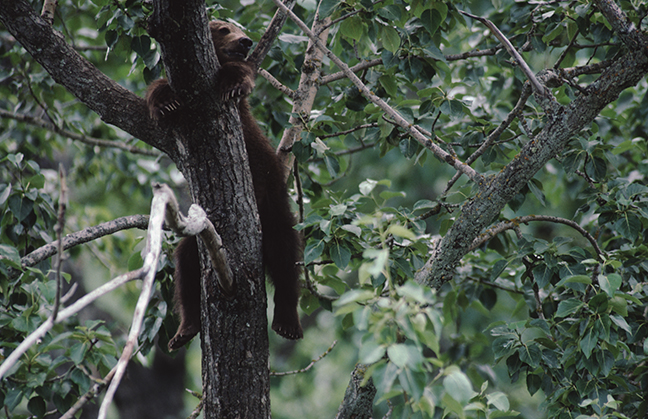
The O’Malley River connects Karluck and O’Malley Lakes on the southwest side of Kodiak Island and is the site of one of the largest concentrations of Brown Bears each summer and early fall when sockeye salmon are spawning. Before 1992, the O'Malley River area was open to unregulated public use. Then, the Kodiak National Wildlife Refuge decided that unregulated use was harming feeding bears and closed the area except for a highly structured bear-viewing program. Two years later, a private guide service operated the program but a legal challenge to the way Mike Munsey, the contractor, was selected shut down the program and since 1995, the O’Malley River area has been closed to public use from June 25-September 30.
Bear viewing began again in June 2011, managed by the ANCSA Regional Native Corporation, Koniag, Inc., which is the owner and operator of the Kodiak Brown Bear Center. Koniag is one of the Native Corporations created by Congress through the passage of the Alaska Native Claims Settlement Act (ANCSA) in 1971. The Center charges more than $1,000/day per person based on double occupancy with a four-day minimum stay.
The program is still controversial as the bear-viewing season ends on Sept. 30 and the bear hunting season begins on October 25, so bears that have been habituated to humans during the summer can be shot by them less than a month later.
The same program also includes bear viewing along Thumb Creek and the 22-mile long Karluk River from a luxury base on Camp Island. The Camp Island I knew and loved in the 1990s is a thing of the past. In those days Pete Devaris, owner of Wilderness Air and later Alaska Coastal Airlines, operated it. Onsite was the late Scott Shelton, who served as guide, cook, boat captain and storyteller. The cabins were simple and efficient and the patrons were friendly and respectful (and they still may be). They reflected Scott’s personality and I was happy to be able to honor him at his memorial service in Ketchikan. I returned only once to Camp Island after his death. My memories were too fresh and painful to enjoy the experience after so many years of sharing the place with him.
I see Pete Devaris and his lovely family regularly in Alaska and he remains a source of inspiration for my work in Alaska. (9/12)
©Rich Beckman


The O’Malley River connects Karluck and O’Malley Lakes on the southwest side of Kodiak Island and is the site of one of the largest concentrations of Brown Bears each summer and early fall when sockeye salmon are spawning. Before 1992, the O'Malley River area was open to unregulated public use. Then, the Kodiak National Wildlife Refuge decided that unregulated use was harming feeding bears and closed the area except for a highly structured bear-viewing program. Two years later, a private guide service operated the program but a legal challenge to the way Mike Munsey, the contractor, was selected shut down the program and since 1995, the O’Malley River area has been closed to public use from June 25-September 30.
Bear viewing began again in June 2011, managed by the ANCSA Regional Native Corporation, Koniag, Inc., which is the owner and operator of the Kodiak Brown Bear Center. Koniag is one of the Native Corporations created by Congress through the passage of the Alaska Native Claims Settlement Act (ANCSA) in 1971. The Center charges more than $1,000/day per person based on double occupancy with a four-day minimum stay.
The program is still controversial as the bear-viewing season ends on Sept. 30 and the bear hunting season begins on October 25, so bears that have been habituated to humans during the summer can be shot by them less than a month later.
The same program also includes bear viewing along Thumb Creek and the 22-mile long Karluk River from a luxury base on Camp Island. The Camp Island I knew and loved in the 1990s is a thing of the past. In those days Pete Devaris, owner of Wilderness Air and later Alaska Coastal Airlines, operated it. Onsite was the late Scott Shelton, who served as guide, cook, boat captain and storyteller. The cabins were simple and efficient and the patrons were friendly and respectful (and they still may be). They reflected Scott’s personality and I was happy to be able to honor him at his memorial service in Ketchikan. I returned only once to Camp Island after his death. My memories were too fresh and painful to enjoy the experience after so many years of sharing the place with him.
I see Pete Devaris and his lovely family regularly in Alaska and he remains a source of inspiration for my work in Alaska. (10/12)
©Rich Beckman

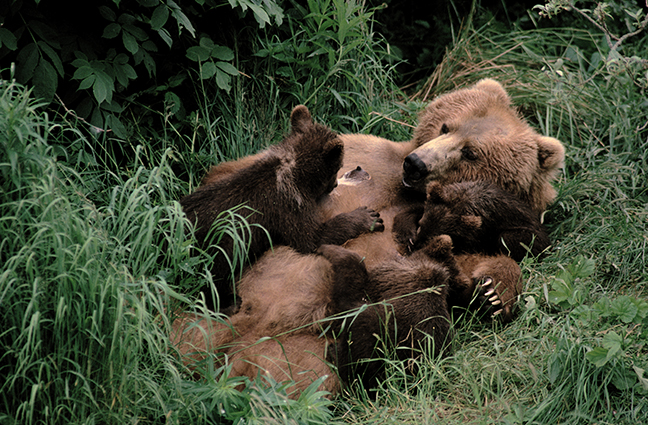
The O’Malley River connects Karluck and O’Malley Lakes on the southwest side of Kodiak Island and is the site of one of the largest concentrations of Brown Bears each summer and early fall when sockeye salmon are spawning. Before 1992, the O'Malley River area was open to unregulated public use. Then, the Kodiak National Wildlife Refuge decided that unregulated use was harming feeding bears and closed the area except for a highly structured bear-viewing program. Two years later, a private guide service operated the program but a legal challenge to the way Mike Munsey, the contractor, was selected shut down the program and since 1995, the O’Malley River area has been closed to public use from June 25-September 30.
Bear viewing began again in June 2011, managed by the ANCSA Regional Native Corporation, Koniag, Inc., which is the owner and operator of the Kodiak Brown Bear Center. Koniag is one of the Native Corporations created by Congress through the passage of the Alaska Native Claims Settlement Act (ANCSA) in 1971. The Center charges more than $1,000/day per person based on double occupancy with a four-day minimum stay.
The program is still controversial as the bear-viewing season ends on Sept. 30 and the bear hunting season begins on October 25, so bears that have been habituated to humans during the summer can be shot by them less than a month later.
The same program also includes bear viewing along Thumb Creek and the 22-mile long Karluk River from a luxury base on Camp Island. The Camp Island I knew and loved in the 1990s is a thing of the past. In those days Pete Devaris, owner of Wilderness Air and later Alaska Coastal Airlines, operated it. Onsite was the late Scott Shelton, who served as guide, cook, boat captain and storyteller. The cabins were simple and efficient and the patrons were friendly and respectful (and they still may be). They reflected Scott’s personality and I was happy to be able to honor him at his memorial service in Ketchikan. I returned only once to Camp Island after his death. My memories were too fresh and painful to enjoy the experience after so many years of sharing the place with him.
I see Pete Devaris and his lovely family regularly in Alaska and he remains a source of inspiration for my work in Alaska. (11/12)
©Rich Beckman

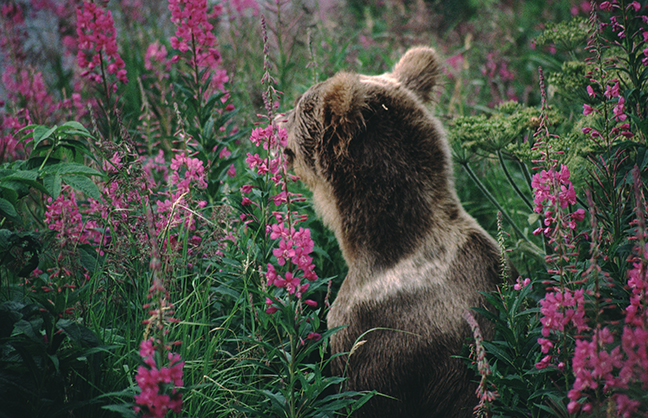
The O’Malley River connects Karluck and O’Malley Lakes on the southwest side of Kodiak Island and is the site of one of the largest concentrations of Brown Bears each summer and early fall when sockeye salmon are spawning. Before 1992, the O'Malley River area was open to unregulated public use. Then, the Kodiak National Wildlife Refuge decided that unregulated use was harming feeding bears and closed the area except for a highly structured bear-viewing program. Two years later, a private guide service operated the program but a legal challenge to the way Mike Munsey, the contractor, was selected shut down the program and since 1995, the O’Malley River area has been closed to public use from June 25-September 30.
Bear viewing began again in June 2011, managed by the ANCSA Regional Native Corporation, Koniag, Inc., which is the owner and operator of the Kodiak Brown Bear Center. Koniag is one of the Native Corporations created by Congress through the passage of the Alaska Native Claims Settlement Act (ANCSA) in 1971. The Center charges more than $1,000/day per person based on double occupancy with a four-day minimum stay.
The program is still controversial as the bear-viewing season ends on Sept. 30 and the bear hunting season begins on October 25, so bears that have been habituated to humans during the summer can be shot by them less than a month later.
The same program also includes bear viewing along Thumb Creek and the 22-mile long Karluk River from a luxury base on Camp Island. The Camp Island I knew and loved in the 1990s is a thing of the past. In those days Pete Devaris, owner of Wilderness Air and later Alaska Coastal Airlines, operated it. Onsite was the late Scott Shelton, who served as guide, cook, boat captain and storyteller. The cabins were simple and efficient and the patrons were friendly and respectful (and they still may be). They reflected Scott’s personality and I was happy to be able to honor him at his memorial service in Ketchikan. I returned only once to Camp Island after his death. My memories were too fresh and painful to enjoy the experience after so many years of sharing the place with him.
I see Pete Devaris and his lovely family regularly in Alaska and he remains a source of inspiration for my work in Alaska. (12/12)
©Rich Beckman